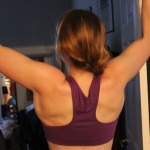Good news and bad news for you this morning.
- The bad news: This is the billionth post dedicated to P90X
- The good news: This is probably the last post dedicated to P90X
I’ve felt so annoying for the past three months talking about our journey doing P90X, but it kind of guided all my choices for healthy living for awhile, so it’s what I had to talk about. Even though we’ve been done for about two weeks now, I wanted to write one last post about it. When we first started P90X, we had no idea what to expect. We knew the workouts were an hour to an hour and a half long, and that was intimidating. We knew that we needed to get some more workout equipment, but we weren’t exactly sure what we HAD to have to complete the program.
Looking back, there are a few things I wish I would have known before starting. We got it all figured out by the end of the three months, but I figure…others are probably in the same boat as we were, so I’m sharing what I wish I knew to hopefully help anyone considering starting P90X.

What Equipment We Absolutely NEEDED
We put off starting P90X for a few weeks because we weren’t sure what exactly we would need. I was willing to buy a set of dumbbells or two to add to our collection, but I didn’t want to buy weights that weren’t appropriate for our needs. By the end of the three months, I found that all I needed was a set of 5 lb, 10 lb, and 15 lb dumbbells. However, I do wish I would have had an 8 lb. and maybe even a 12 lb. We also had a set of 20 lb. dumbbells that Matt settled with, even though he needed much heavier for certain exercises. The resistance band route intrigued us, but ultimately, we went with the dumbbell option.
If you’re curious, this is the only equipment Matt and I used throughout the program (most of which we already had):
- 5, 10, 15, and 20 lb. dumbbells (borrowed the set of 15’s from a friend to save some money)
- Pushup bars
- Pullup bar (got ours from Ross for about $20)
- Yoga mats (got two from Marshalls, $15 to $20 each)
- Chair (to help me with pullups and for chair dips)
- Towel (for the towel pullups and for jumping exercises)
Every Workout Isn’t Going to Be Amazing
When it comes to persevering through the three-month program, they say, “Just keep pressing play.” Not every workout is going to be an amazing one because, at least for me, giving 100% on a daily basis is not the most realistic. Some days you’re just not feeling it. At first this was a bit discouraging because I would dedicate all this time to a workout and then feel like I didn’t give enough. I’ve heard people say in regards to working out, “Don’t just go through the motions; give 100%.” Sure, that would be ideal on a daily basis, but sometimes, I think going through the motions is exactly what you need to keep up with a routine. Can’t dwell on it; just got’ta get back on the horse the next day and do your best.
Leftovers Are Your Best Friend
For the first month of the program, I was pretty intense with the nutrition plan. I planned every meal and snack, which was really time-consuming and mentally draining, considering I usually only plan three to four dinner ideas every week and just wing the rest. After awhile, I found that just making healthy dinners and having enough for leftovers the next day for lunch was extremely helpful and so convenient. I find healthy cooking to be a lot of effort sometimes, since it often means making food from scratch and spending way more time preparing meals. Getting two meals out of one cooking session made my life so much easier.
Write Down Your Weight and Rep Number

I didn’t do this for the first couple weeks, but I gradually understood how important it was. By writing down the dumbbell weight and how many reps you did of the exercise, it helps you,
- See progress and
- Know what to pick next time for a realistic challenge.
Before I started writing this down, I would always have to guess which weight to use. Knowing what I did the previous time helped me be more efficient, as well as pick the most effective dumbbell weight.
Do What You Can of the Real Exercise; THEN Modify It
The classic P90X routine is pretty upper body strength-focused. I do not have the strongest upper body. Pushups, for instance, especially with the pushup bars that allow you to go even deeper, are quite difficult for me, and I can’t do very many. As I went through the program, I found that instead of just starting with pushups on my knees, I got more out of the workout when I did as many normal ones as I could and THEN moving to pushups on my knees. That way,
- I’m not doing three pushups and wasting the rest of the time watching everyone else finish or
- I’m not doing a bunch on my knees when I’m actually capable of doing some real ones.
Progress is way more exciting when you’re seeing a difference in your ability to do the exercise how it’s supposed to be done.
Substituting Workouts Isn’t the Worst Thing Ever
I did my best to follow the P90X schedule EXACTLY for the first month and a half. Then I started being more lenient on myself and going on runs, rather than doing cardio workouts like Kenpo or Plyometrics. Giving myself a little freedom like this made doing the program 10x better. I started to hate some of the exercises/workouts, so substituting my own choice of cardio workout for the scheduled ones made finishing the program so much easier.
And that just about sums it up. If you’re interested, make sure to check out my final P90X results!





Good tips. The only piece I don’t have is the pull up bar. I kind of go back and forth as to whether I need one in my home gym
Ya, I never would have bought one on my own, but it’s actually pretty cool to incorporate pullup variations into workouts. I also want to use it for core exercises as well.
Great tips! I would echo every one of them!